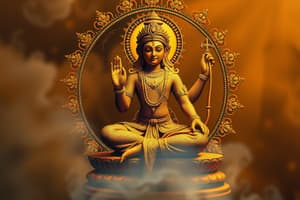Podcast
Questions and Answers
What does the term 'Sanatana Dharma' mean?
What does the term 'Sanatana Dharma' mean?
- A set of rules defined by government
- Dharma that is always there (correct)
- A law that is flexible and changes with society
- Dharma that is only relevant to a particular region
How is Dharma defined in Samskrita Vyakaranam?
How is Dharma defined in Samskrita Vyakaranam?
- That which brings joy to individuals
- A term used to refer to cultural traditions
- The moral codes set by society
- That which upholds and supports beings (correct)
What role did Rishis play in relation to Sanatana Dharma?
What role did Rishis play in relation to Sanatana Dharma?
- They were ancient seers who discovered eternal laws (correct)
- They were political leaders who enforced laws
- They were merchants who spread the faith
- They compiled texts that contradicted Sanatana Dharma
Which aspect distinguishes Sanatana Dharma from geographical definitions?
Which aspect distinguishes Sanatana Dharma from geographical definitions?
What analogy does Sadguru Mata Amritanandamayi use to illustrate the concept of Sanatana Dharma?
What analogy does Sadguru Mata Amritanandamayi use to illustrate the concept of Sanatana Dharma?
Which of the following is NOT a characteristic of Dharma as per the provided content?
Which of the following is NOT a characteristic of Dharma as per the provided content?
What is the significance of the term 'Hindu' in relation to Sanatana Dharma?
What is the significance of the term 'Hindu' in relation to Sanatana Dharma?
How should Sanatana Dharma be viewed in a modern context?
How should Sanatana Dharma be viewed in a modern context?
What does Sanatana Dharma assert about all beings?
What does Sanatana Dharma assert about all beings?
Which principle best describes the attitude of traditions within Sanatana Dharma?
Which principle best describes the attitude of traditions within Sanatana Dharma?
According to Sanatana Dharma, what is considered everyone's birthright?
According to Sanatana Dharma, what is considered everyone's birthright?
What is the attitude of Sanatana Dharma towards other traditions?
What is the attitude of Sanatana Dharma towards other traditions?
What does the verse from Devi Mahatmyam of Brahmandapurana highlight?
What does the verse from Devi Mahatmyam of Brahmandapurana highlight?
What does Yudhishthira imply about arguments and knowledge in the context of understanding Dharma?
What does Yudhishthira imply about arguments and knowledge in the context of understanding Dharma?
How does Adi Shankaracharya define Satyam?
How does Adi Shankaracharya define Satyam?
According to the passage, what is the significance of Mahatmas in understanding Dharma?
According to the passage, what is the significance of Mahatmas in understanding Dharma?
What role do the shastras play in the understanding of Dharma?
What role do the shastras play in the understanding of Dharma?
What is meant by the phrase 'Om Lokah Samastah Sukhino Bhavantu' in the context of Sanatana Dharma?
What is meant by the phrase 'Om Lokah Samastah Sukhino Bhavantu' in the context of Sanatana Dharma?
In what way has Sanatana Dharma been described in relation to other ancient cultures?
In what way has Sanatana Dharma been described in relation to other ancient cultures?
What does the content suggest about the relationship between Dharma and community wisdom?
What does the content suggest about the relationship between Dharma and community wisdom?
What does Amma's saying 'Ennile njananu nee, Ninnile nee aanuu njan' emphasize?
What does Amma's saying 'Ennile njananu nee, Ninnile nee aanuu njan' emphasize?
What does Sanatana Dharma emphasize about the paths individuals take towards the Paramatman?
What does Sanatana Dharma emphasize about the paths individuals take towards the Paramatman?
Which principle is shared among all traditions within Sanatana Dharma?
Which principle is shared among all traditions within Sanatana Dharma?
How is the concept of God described in the Shvetashvatara Upanishad?
How is the concept of God described in the Shvetashvatara Upanishad?
What role does the Guru play in the context of Sanatana Dharma?
What role does the Guru play in the context of Sanatana Dharma?
What does the term 'Paramatman' refer to in Sanatana Dharma?
What does the term 'Paramatman' refer to in Sanatana Dharma?
Which of the following texts distinguishes the many names attributed to the singular God?
Which of the following texts distinguishes the many names attributed to the singular God?
What does the phrase 'living and letting live' imply within Sanatana Dharma?
What does the phrase 'living and letting live' imply within Sanatana Dharma?
What is an essential feature of Sanatana Dharma according to the given content?
What is an essential feature of Sanatana Dharma according to the given content?
What is the primary responsibility assigned to mankind in relation to Dharma?
What is the primary responsibility assigned to mankind in relation to Dharma?
According to the concepts discussed, what does 'Prakriti' refer to?
According to the concepts discussed, what does 'Prakriti' refer to?
What does 'Satyam Vada, Dharmam Cara' instruct individuals to practice?
What does 'Satyam Vada, Dharmam Cara' instruct individuals to practice?
In Mahabharata, what does Maharshi Narada suggest is 'superior to the truth'?
In Mahabharata, what does Maharshi Narada suggest is 'superior to the truth'?
How is 'Satya' defined in the context provided, beyond the common understanding?
How is 'Satya' defined in the context provided, beyond the common understanding?
What dilemma does the definition of 'bhutahitam' help to address?
What dilemma does the definition of 'bhutahitam' help to address?
What aspect of mankind sets it apart from all other beings regarding Dharma?
What aspect of mankind sets it apart from all other beings regarding Dharma?
What significant event involved the Brahmin named Satyavrata?
What significant event involved the Brahmin named Satyavrata?
Flashcards are hidden until you start studying
Study Notes
Sanatana Dharma Overview
- Sanatana Dharma is often equated with Hinduism, although Hinduism is derived from the English language and has various origins, primarily linked to the Indus River (Sindhu).
- It cannot be defined geographically or politically; it embodies timeless, universal laws existing beyond human perception.
- The term 'Sanatana Dharma' translates to "the eternal Dharma," signifying its everlasting nature.
Concepts of Dharma
- In Sanskrit, 'Sana' means 'always' and 'tana' means 'that which is there', thus defining Sanatana Dharma.
- Dharma can be defined as that which upholds and supports all beings in the universe, contributing to their wellness and progress.
- It is essential for individuals, especially humans, to discern and understand Dharma, as only they possess the capability to deviate from it.
Human Responsibility
- Unlike other beings that follow Dharma instinctively, humans have the free will to choose or ignore it.
- Mankind can refine itself (Samskriti) or deteriorate (Vikriti) based on their understanding of Dharma.
- The Taittiriya Upanishad encourages adherence to truth and Dharma: “Speak the truth. Practice Dharma.”
Understanding Truth (Satyam)
- 'Satyam' is traditionally understood as that which has happened; however, it is more accurately described as 'Bhutahitam' or what is beneficial to the world.
- Truth is weighed against potential outcomes, suggesting that beneficial words can take precedence over strict honesty.
- The Mahabharata illustrates the importance of discerning Dharma through the story of Yudhishthira, who acknowledges the complexity of understanding it.
Guidance and Knowledge
- Only enlightened individuals (Mahatmas) can help navigate the subtleties of Dharma.
- Learning Dharma involves consulting the teachings of the elders and studying scriptures like Itihasas, Puranas, Vedas, and Upanishads.
Diversity within Sanatana Dharma
- The tradition accommodates numerous paths and beliefs (Sankhya, Yoga, Shaiva, Vaishnava) all leading towards the same ultimate truth.
- Sanatana Dharma promotes a culture of coexistence and respect for diverse beliefs, encouraging living and letting live.
- Core injunctions emphasize universal compassion; ''Om Lokah Samastah Sukhino Bhavantu'' reflects the desire for the happiness of all beings.
Philosophical Insights
- The Rigveda highlights the concept of singular divinity perceived through various manifestations (e.g., Indra, Agni).
- Upanishads promote the idea of the divine presence in all beings, advocating unity and interconnectedness.
Path to Spiritual Realization
- Individuals are on a journey toward realizing their divine nature (Paramatman), knowingly or unknowingly.
- The role of a Guru is vital in identifying the most suitable spiritual path, facilitating a more direct route to enlightenment.
Conclusion
- Sanatana Dharma is recognized as the largest pluralistic, ancient tradition that respects and nurtures individual spiritual growth.
- Eternal happiness is posited as the birthright of every individual, achievable through understanding and practicing Dharma.
Studying That Suits You
Use AI to generate personalized quizzes and flashcards to suit your learning preferences.




